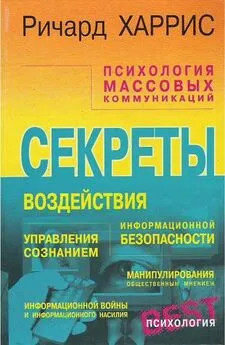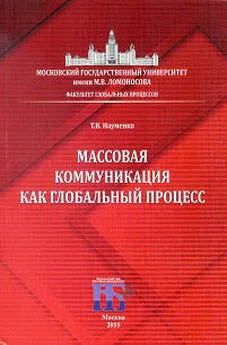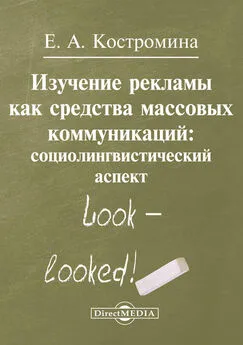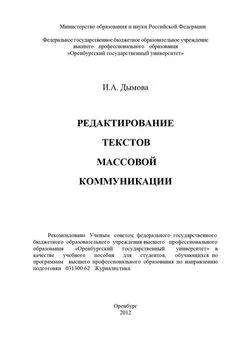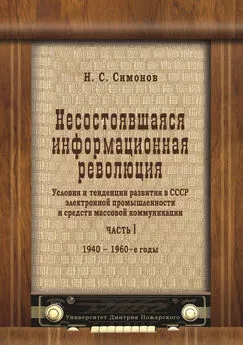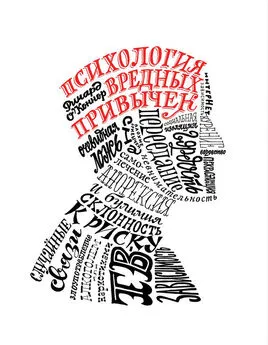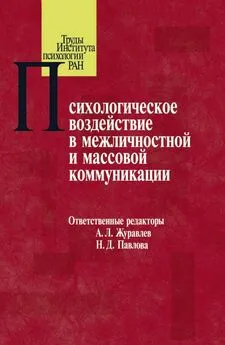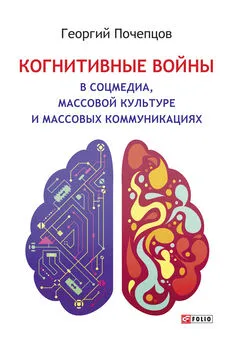Ричард Харрис - Психология массовых коммуникаций
- Название:Психология массовых коммуникаций
- Автор:
- Жанр:
- Издательство:2002
- Год:2002
- Город:Санкт-Петербург
- ISBN:5-93878-033-0
- Рейтинг:
- Избранное:Добавить в избранное
-
Отзывы:
-
Ваша оценка:
Ричард Харрис - Психология массовых коммуникаций краткое содержание
«Предупреждён – значит вооружён». Такой эпиграф мог бы открывать эту книгу. И не имеет значения, кто возьмёт её в руки. Специалист почерпнёт в ней новые приёмы и подходы к анализу стратегии и тактики СМИ. Любознательный обыватель научится обеспечивать собственную информационную безопасность.
Кроме того картина информационного ландшафта современного общества от предвыборного управления массовым сознанием до рекламы памперсов оказывается настолько захватывающей, что однажды начав читать эту книгу, вы уже не оставите её недочитанной.
Психология массовых коммуникаций - читать онлайн бесплатно полную версию (весь текст целиком)
Интервал:
Закладка:
Beagles-Roos, J., Gat, I. (1983). Specific impact of radio and television on children's story comprehension. Journal of Educational Psychology, 75, 128–137.
Beeman, W. O. (1984). The cultural role of the media in Iran: The revolution of 1978–1979 and after. In: A. Arno W. Dissayanake (Eds.). The news media and national and international conflict (p. 147–165). Boulder, CO: Westview Press.
Beentjes, J. W. J., van der Voort, Т . Н . A. (1989). Television and young people's reading behavior: A review of research. European Journal of Communication, 4, 451–477.
Bcllafante, G. (1995, March 27). Playing "Get the Guest". Time. 77.
Benedict, H. (1992). Virgin or vamp: How the press covers sex crimes. New York: Oxford University Press.
Berelson. B. R., Lazarsfeld, P. F, McPhee, W. N. (1954). Voting. Chicago: University of Chicago Press.
Berkowitz, L. (1965). Some aspects of observed aggression. Journal of Personality and Social Psychology, 2, 359–369.
Berkowitz, L. (1984). Some effects of thoughts on anti-and prosocial influences of media events:A cognitive neoassociation analysis. Psychological Bulletin. 95, 410–427.
Berry, G. L. (1980). Television and Afro Americans: Past legacy and present portrayals. In: S. B. Withey R. P. Abeles (Eds.). Television and social behavior (p. 231–247). Hillsdale, NJ: Lawrence Eribaum Associates.
Berry, G. L, Asamen, J. K. (Eds.). (1993). Children and television: Images in a changing sociocultural world. Newbury Park, CA: Sage.
Berry, V. T. (1992). From Good Times to The Cosby Show: Perceptions of changing televised images among black fathers and sons. In: S. Craig (Ed.). Men, masculinity. and the media (p. 111–123). Newbury Park, CA: Sage.
Biocca. F. (1990). Semiotics and mass communication: Points of intersection. In: T. Sebeok J. Umiker-Sebeok (Eds.). Semiotic web. The Hague, the Netherlands: Mouton.
Biocca, F. (Ed.). (1991 a). Television and political advertising: Vol. I. Psychological processes. Hillsdale, NJ: Lawrence Eribaum Associates.
Bird, S. E. (Ed.) (1996). Dressing in feathers: The construction of the Indian in popular culture. Boulder, CO: Westview Press.
Blatt, J., Spencer, L, Ward, S. (1972). A cognitive developmental study of children's reactions to television advertising. In: E. A. Rubinstein, G. A. Comstock, J. P. Murray (Eds.). Television and social behavior: Vol. 4. Television in everyday life: Patterns of use (p. 452–467). Washington, DC: U. S. Government Printing Office.
Block, C. (1972). White backlash to Negro ads: Fact or fantasy? Journalism Quarterly, 49(2), 253–262. Bloom. P. N. Novell, W. D. (1981). Problems and challenges in social marketing. Journal of Marketing, 45(2), 79–88.
Blumler, J. G. (1979). The role of theory in uses and gratifications research. Communication Research, 6, 9–36.
Blumler. J. G., Katz, E. (Eds.). (1974). The uses of mass communications: Currentperspectives on gratifications research. Beverly Hills: Sage. Blumler, J. G.. McLeod, J. M., Rosengren, К . Е . (Eds.). (1992), Comparatively speaking: Communication and culture across space and time. Newbury Park, CA: Sage.
Blumler. J. G., McQuail, D. (1969). Television in politics: Its uses and influences. Chicago, 1L: University of Chicago Press.
Bogart. L. (1980). Television news as entertainment. In: R H. Tannenbaum (Ed.). The entertainment functions of television (p. 209–249). Hillsdale, NJ: Lawrence Eribaum Associates.
Bogart, L. (1981). Press and public. Hillsdale, NJ: Lawrence Eribaum Associates.
Bogatz, G. A., Ball, S. (1972). The second year of Sesame Street: A continuing evaluation. Princeton, NJ: Educational Testing Service.
Bogle, D. (1973). Toms, coons, mulattoes, and bucks: An interpretive history of Blacks in American films. New York: Viking.
Boiney, J., Paletz, D. L. (1991). In search of the model model: Political science versus political advertising perspectives on voter decision making. In: F. Biocca (Ed.). Television and political advertising: Vol. I. Psychological processes (p. 3–25). Hillsdale, NJ: Lawrence Eribaum Associates.
Bollen, K. A.. Phillips, D. P. (1982). Imitative suicides: A national study of the effects of television news stories. American Sociological Review, 47, 802–809. Bordeaux. B. R., Lange, G. (1991). Children's reported investment of mental effort when viewing television. Communication Research, 18, 617–635. Borden. D. L., Harvey, K. (Eds.). (1997). The electronic grapevine: Rumor, reputation, and reporting in the new on-line environment. Mahwah. NJ: Lawrence Eribaum Associates.
Bower, G. H., Black. J. В .. Turner, T. J. (1979). Scripts in memory for text. Cognitive Psychology, II. 177–220.
Bowman, J. (1996). The dirty little secret of educational. TV The Weekly Standard. /(16–17), 22–26. Brabant, S., Mooney, L. (1986). Sex role stereotyping in the Sunday comics. Sex Roles /4(3/4), 141–148. Brcslow, L. (1978). Risk factor intervention for health maintenance. Science, 200, 908–912. Brewer, W. F., Nakamura, G. V (1984). The nature and functions ofschcmas. In: R. S. Wyer T. K. Srull (Eds.). Handbook of social cognition. Hillsdale, NJ: Lawrence Eribaum Associates.
Brosius, H. B. (1993). The effects of emotional pictures in television news. Communication Research, 20, 105–124.
Brosius, H. B., Kepplinger. H. M. (1990). The agenda setting function of television news: Static and dynamic views. Communication Research, 17, 183–211. Brown. D., Bryant, J. (1983). Humor in mass media. In: P. E. McGhee J. H. Goldstein (Eds.). Handbook of humor research (Vol. 2). New York: Springer-Verlag. Brown, D., Bryant, J. (1990). Effects of television on family values and selected attitudes and behaviors. In: J. Bryant (Ed.). Television and the American family (p. 227–251). Hillsdale, NJ: Lawrence Eribaum Associates.
Brown, J. A. (1991). Television "critical viewing skills" education: Major media literacy projects in the United States and selected countries. Hillsdale, NJ: Lawrence Eribaum Associates.
Brown, J. A. (1998). Media literacy perspectives. Journal of Communication, 4S(I) 44–57.
Brown, J. D., Campbell, K. (1986). Race and gender in music videos: The same beat but a different drummer. Journal of Communication, 36(1), 94–106.
Brown, J. D., Einsiedel, E. F. (1990). Public health campaigns: Mass media strategies. In: E. B. Ray L. Donohew (Eds.). Communication and health: Systems and applications (p. 153–170). Hillsdale, NJ: Lawrence Eribaum Associates.
Brown, J. D., Walsh-Childers, K. (1994). Effects of media on personal and public health. In J. Bryant D. Zillmann (Eds.). Media effects (p. 389–415). Hillsdale NJ: Lawrence Eribaum Associates.
Brown, N. R., Siegler, R. S. (1992). The role of availability in the estimation of national populations. Memory Cognition, 20, 406–412.
Brown, W. J., Cody, M. J. (1991). Effects of a pro-social television soap opera in promoting women's status. Human Communication Research, 18, 114–142.
Brown, W. J., Singhal, A. (1990). Ethical dilemmas of prosocial television. Communication Quarterly, 38, 268–280.
Brown, W.I, Singhal, A., Rogers, E. M. (1989). Prodevelopment soap operas: A novel approach to development communication. Media Development, 36(4), 43–47.
Bruce, S. (1990), Pray TV: Televangelism in America. London: Routiedge.
Bruno. K. J., Harris, R. J. (1980). The effect of repetition on the discrimination of asserted and implied claims in advertising. Applied Psycholinguistics, 1, 307–321.
Bryant, J. (Ed.). (1990). Television and the American family. Hillsdale, NJ: Lawrence Eribaum Associates. Bryant, J., Alexander, A. R, Brown, D. (1983). Learning from educational television programs. In: M. J. A. Howc (Ed.). Learning from television: Psychological and educational research (p. 1–30). London: Academic Press.
Bryant. J., Rockwell. S. C. (1994). Effects of massive exposure to sexually oriented prime time television programming on adolescents moral judgment. In: D. Zillmann. J. Bryant, A. C. Huston (Eds.). Media, children, and the family: Social scientific, psychodynamic, and clinical perspectives (p. 183–195). Hillsdale NJ: Lawrence Eribaum Associates.
Buchholz. M., Bynum. J. (1982). Newspaper presentation of America's aged: A content analysis of image and role. The Gerontologist, 22, 83–88.
Buckingham, D. (1993). Children talking television: The making of television literacy. London: Palmer. Buckingham, D. (1996). Critical pedagogy and media education: A theory in search of a practice. Journal of Curriculum Studies. 28(ff), 627–650.
Buckingham, D. (1998). Media education in the UK: Moving beyond protectionism. Journal of Communication, 48, 33–43.
Buerkel-Rothfuss, N. L., Mayes, S. (1981). Soap opera viewing: The cultivation effect. Journal of Communication, 31, 108–115.
Bullard. S. (1998). Gangstawulf: Examining the allure of violence in lyric form. Teaching Tolerance, 7(1), 16–19.
Burke. R. R., DeSarbo, W. S., Oliver, R. L., Robertson. T. S. (1988). Deception by implication: An experimental investigation. Journal of Consumer Research. 14, 483–494.
Busby, L. J. (1985). The mass media and sex-role socialization. In: J. R. Dominick J. E. Fletcher (Eds.). Broadcasting research methods (p. 267–295). Boston: Allyn Bacon.
Calvert, S. L. (1988). Television production feature effects of children's comprehension oftime. Journal of Applied Developmental Psychology, 9, 263–273.
Cameron. G. T, Frieske, D. A. (1994). The time needed to answer: Measurement of memory response latency. In: A. Lang (Ed.). Measuring psychological responses to media (p. 149–164). Hillsdale NJ: Lawrence Eribaum Associates.
Canadian case. (1996, June 20). Kansas State Collegian, p. 2.
Cantor, J. (1991). Fright responses to mass media productions. In: J. Bryant D. Zillmann (Eds.). Responding to the screen: Reception and reaction processes (p. 169–197). Hillsdale, NJ: Lawrence Eribaum Associates.
Cantor, J. (1996). Television and children's fear. In: T. M. Macbeth. Tuning in to young viewers: Social science perspectives on television (p. 87–115). Thousand Oaks, CA: Sage.
Cantor, J. (1998). Ratings for program content: The role of research findings. The Annals of the American Academy of Political and Social Science, 557, 54–69.
Cantor, J., Nathanson. A. I. (1996). Children's fright reactions to television news. Journal of Communication, 46(4), 139–152.
Cantor, J., Oliver, M. B. (1996). Developmental differences in responses to horror. In: J. B. Weaver R. Tamborini (Eds.). Horror films: Current research on audience preferences and reactions (p. 63–80). Mahwah, NJ: Lawrence Eribaum Associates.
Cantor, J., Sparks, G. G. (1984). Children's fear responses to mass media: Testing some Piagctian predictions. Journal of Communication, 34, 90–103.
Cantor, J., Venus, P. (1980). The effect of humor on recall of a radio advertisement. Journal of Broadcasting, 24(1), 13–22.
Cantor. M. G. Cantor, J. M. (1986). American television in the international marketplace. Communication Research, 13, 509–520. Carlson, M. (1990, September 10). A new ball game. Time, 40–41.
Carlson. M. (1996, August 5). The soap opera games. Time, 48.
Can-oil. J. S., Kerr, N. L., Alflni, J. J., Weaver, F. M., MacCount. R. J., Fcldman, V (1986). Free ргеяч and fair trial: The role of behavioral research. Law and Human Behavior, 10, 187–202.
Carveth, R., Alexander. A. (1985). Soap opera viewing motivations and the cultivation process. Journal of Broadcasting Electronic Media, 29, 259–273.
Cassata. M., Inwin, B. J. (1997). Young by day: The older person on daytime serial drama. In: H. S. No-orAI-deen (Ed.). Cross-cultural communication and aging in the United States (p. 215–230). Mahwah, NJ: Lawrence Eribaum Associates.
Читать дальшеИнтервал:
Закладка:
